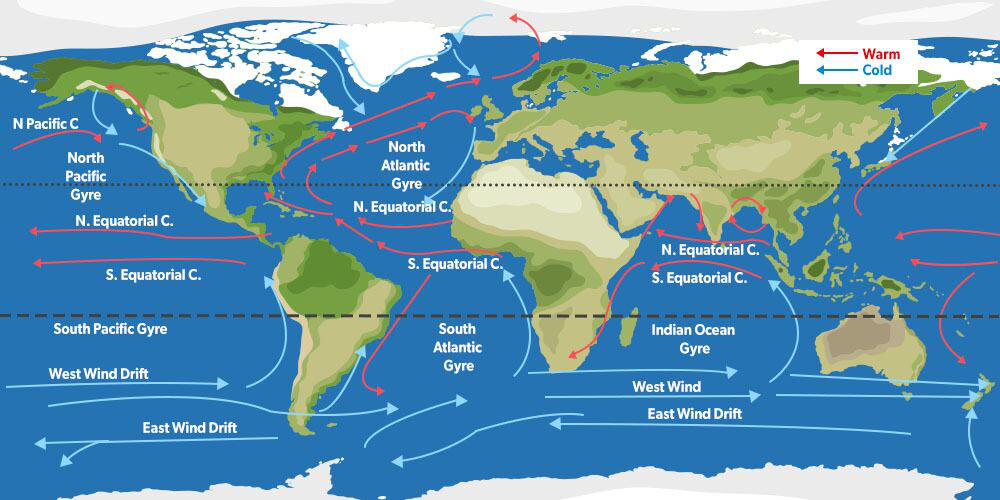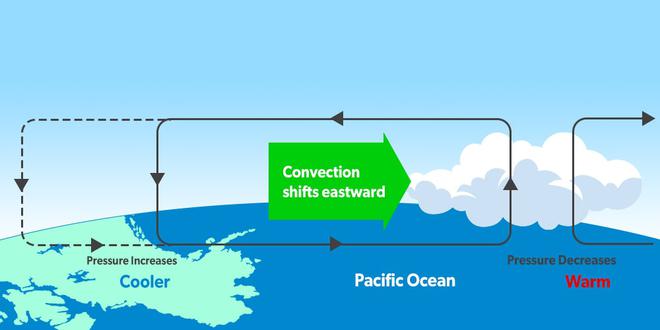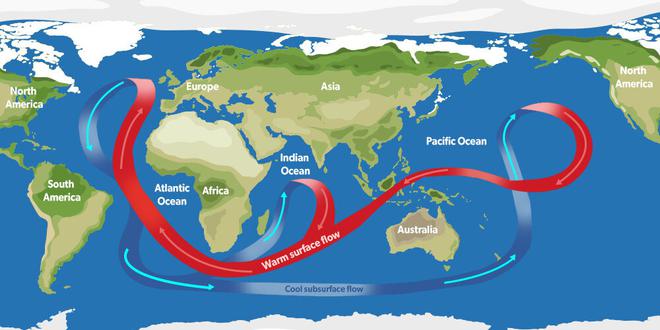Ocean currents refer to the horizontal movement of the seawater which is produced with the help of gravity, wind, and water density. Ocean currents play a vital role in the determination of the climates in the coastal areas. Ocean currents move in two directions: horizontally known as currents and vertically which is known as upwellings or downwelling.
Ocean Currents
Ocean currents are a continuous, directional, and predictable movement of the seawater and are a massive movement in oceans that is caused and influenced by different factors. The direction in which ocean currents move is of two types: horizontally and vertically:
- Horizontal movements are those such as currents, while vertical changes are known as upwellings or as downwelling.
- The impact of ocean currents is on both humans and also biosphere due to their influences on climate.
Ocean Water and Ocean Currents
The movement of the ocean currents is mostly continuous and the movement can be categorized broadly as:
- Waves
- Tides
- Currents
The ocean currents refer to the streams of water which flow constantly as the ocean surface with definite directions. Ocean currents are one of the important factors which influence the temperature of ocean water.
The distribution of ocean currents is as below:

The oceans absorb most of the solar radiation falling on them, mainly in tropical areas where most of the radiation is received. This heat is transported poleward by ocean currents along the western margins of the oceans. On reaching the higher latitudes, this heat is lost at the surface as latent heat through evaporation, sensible heat flux, and infrared radiations, thus warming the regions near the coast of the eastern margins of the continents.

The North-Atlantic Drift as an extension of the Gulf Stream brings warm water to the North-Western European Coasts, allowing them to remain ice-free even in winter. Quebec, though located at a lower latitude, on the Canadian coast is frozen due to the Cold Labrador Current flowing past it.
To compensate for the water loss in the tropics, cold water from the polar and temperate regions is transported to tropical areas along the eastern margin of the oceans. Hence, the western margins of continents are relatively colder than the western margin along the same latitude. Hence, ocean currents act as a moderating agent along the longitudes and impact the global climatic pattern along the latitudes.
The ocean currents also influence local weather conditions by warming or cooling the lower atmosphere. A warm ocean current warms the air above it, causing upward convection currents in the atmosphere. The upward movement of air results in cloud formation and hence precipitation is caused in the regions near the coast. On the other hand, a cold ocean current cools the air above it, resulting in the sinking of air and hence no cloud formation. This results in cold dry conditions in the coastal regions. This factor, supported by trade winds and the sinking arm of Hadley’s meridional cell has contributed to the formation of subtropical deserts along the western portions of the continents. For example, the Sahara Desert and the Kalahari Desert in Africa, the Great Australian Desert in Australia, the Atacama Desert in South America, and the Great Western Desert in North America. These desert regions become very hot in the summer and very cold in the winter.

Walker cell is a vertical latitudinal atmospheric circulation produced as a result of rising air over the warm waters of the Eastern Australian Current and sinking air over the cold Humboldt Current along the Peruvian Coast. One arm of vertical rising air over the Eastern Australian Current diverges towards the Indian Ocean, which strengthens the Indian Monsoon. However, at times, due to the weakening of trade winds in the Pacific Ocean, water flows backward from the Warm Water Pool along the Australian North Eastern Corner, thereby replacing the cold Humboldt Current with a warm water current. This causes cloud formations along the Peruvian coast and hence more than normal rainfall in the region. This reverses the direction of Walker Cell and the phenomenon is called El Nino. Now, air sinks above the Eastern Australian Coast, and hence no arm diverges towards the Indian Ocean, thereby weakening the South West Monsoon over the Indian subcontinent. Conversely, when Humboldt Current becomes extremely cold (the phenomena of La Nina), the Indian Ocean arm of the Walker Cell gets strengthened more than usual. This causes excessive rainfall over the Indian subcontinent while causing excessive acidity along the Peruvian coast.


At some land-ocean boundaries, upwelling caused by the offshore winds brings cold water and nutrients brings from below. This moderates the climate in the tropics and lowers the temperature further in temperate regions.

Thermohaline circulation is also believed to impact climate since it transports a large amount of mass and energy. However, it is difficult to quantify its impact.
Factors Influencing Ocean Currents
The following factors are responsible for ocean currents:
Planetary Winds
The dominant factor responsible for the formation of ocean currents is the planetary winds. The trade winds push the surface water toward the west near the equator, while westerlies in the temperate regions carry the water to the east. The proof of planetary winds as the dominant factor is seen in the North Indian Ocean, where the direction of the current reverses with the reversal of the direction of the winds.

The winds blowing along the coast are responsible for upwelling and downwelling following the Ekman Transport phenomena.

Earth’s Rotation
The Coriolis force is a pseudo force resulting from the rotation of the Earth. It deflects moving water to the right in the northern hemisphere and left in the southern hemisphere. Hence, the gyres are formed circulating in a clockwise direction in the Northern Hemisphere and anti-clockwise in the Southern Hemisphere.

Obstruction from land
The obstruction from land defines the size of gyres and hence the speed of ocean currents. The Atlantic Ocean Gyre is smaller in size and hence the Gulf Stream and other currents move rapidly. While in the larger Pacific Ocean, the Gyre formed is large, and hence the current moves slowly.
Temperature and Salinity
The vertical motion of water is driven by a density gradient. The surface water in the higher latitudes is cold making it dense. Further, due to high-velocity winds, the evaporation rate is high, leaving behind more saline water. This further increases the density. This dense water sinks vertically down, starting the thermohaline circulation.

Without ocean currents, the temperature at the poles would be extremely low and the temperature at the equator would have been extremely high. Most places on land would have been inhabitable. The conveyor belt of oceans from the equator to the poles and back has helped in keeping the temperature moderate.
Types of Ocean Currents
Ocean currents are of the following types:
Surface currents- They are the large-scale surface currents that are mostly driven by the world’s wind systems which are fueled by energy from the sun.
Deep water currents- The differences in the density of water, result in the variability of water temperature as well as salinity, which results in ocean currents.
Ocean currents can be classified on the basis of temperature:
Cold currents- The cold currents bring cold water into the warm water areas.
Warm currents- Warm currents refer to those which bring warm water into the cold water areas and are observed normally on the east coast of continents.
Characteristics of Ocean Currents
- Ocean currents are influenced by the stresses which is exerted by the prevailing winds as well as Coriolis force.
- The middle latitudes are mainly anticyclonic. At higher altitudes, the wind flow is mostly cyclonic.
- Monsoon winds influence the ocean currents.
- Coriolis force, low currents from lower latitudes move to right in northern hemisphere and to left in southern hemisphere.
- Oceanic circulations transport heat from one latitude belt to another. Cold waters of Arctic and Antarctic circles move to warmer water in tropical areas, warm waters move towards pole wards.
Effects of Ocean Currents
| Effects of Ocean Currents |
| Climatic Conditions |
| Rainfall |
| Fog Formation |
| Creates Fishing Zone |
| Desert Formation |
| Violent Storms |
Distribution of Ocean Currents
The ocean currents are distributed based on five oceans; as listed below:
| Ocean Currents in Arctic Ocean |
| Ocean Current |
Cold/Warm |
| Baffin Island Current |
Cold |
| Labrador Current |
Cold |
| Ocean Currents in Atlantic Ocean |
| Angola Current |
Warm |
| Antilles Current |
Warm |
| Benguela Current |
Cold |
| Brazil Current |
Warm |
| Cape Horn Current |
Cold |
| Caribbean Current |
Warm |
| Falkland Current |
Cold |
| Florida Current |
Warm |
| North Atlantic Current |
Warm |
| South Atlantic Current |
Cold |
| Ocean Currents in Indian Ocean |
| Agulhas Current |
Warm |
| Leeuwin Current |
Warm |
| Mozambique Current |
Warm |
| West Australian Current |
Cold |
| Ocean Currents in Pacific Ocean |
| Alaska Current |
Warm |
| Humboldt Current |
Cold |
| Kamchatka Current |
Cold |
| Kuroshio Current |
Warm |
| North Pacific Current |
Warm |
Related Links
- The Main Ocean Currents of the World
- Ocean Circulation
- Ocean Floor
- How many oceans are there?
- Oceans and its Water Straits
- Salinity of Ocean Water
- Ocean Currents
FAQs on Ocean Currents
Q 1. What are the five major ocean currents?
Answer-
The five major ocean currents are North Atlantic, South Atlantic, North Pacific, South Pacific and Indian Ocean.
Q 2. What are ocean currents and their types?
Answer-
Ocean currents refer to the continuous, predictable, directional movements which have been driven with the forces of gravity, wind, and also density of water.
Q 3. What are two major ocean currents?
Answer-
The two major ocean currents include the following:
- Surface Currents
- Deep Ocean Currents
Q 4. What are the causes of ocean currents?
Answer-
The causes of ocean currents include wind, density differences in water masses, gravity and events like storms.
Like Article
Suggest improvement
Share your thoughts in the comments
Please Login to comment...